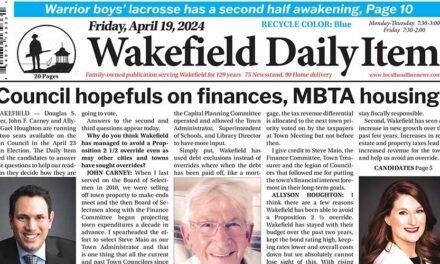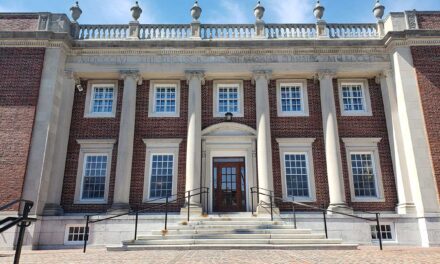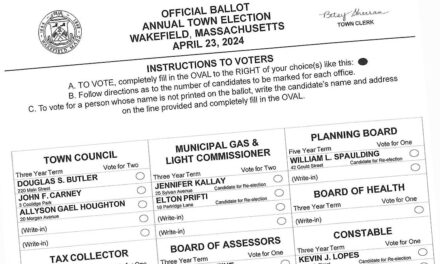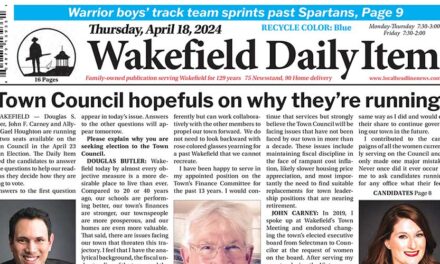Published in the June 13, 2017 edition.
By MARK SARDELLA
WAKEFIELD — The Board of Selectmen last night set the water and sewer rates for FY 2018, approving the rates recommended by the June 1, 2017 vote of the Advisory Board of Public Works.
The new water rate will be $6.95 per 100 cubic feet of consumption. The new sewer rate will be $10.90 per 100 c.f., for a combined rate of 17.85 per 100 c.f.
Public Works Director Richard Stinson appeared the selectmen last night along with DPW Business and Operations Manager Carol Antonelli to discuss the new rates.
Stinson said that the new combined rate represents an increase of 4.7 percent over last year’s rate after the discount is taken.
The new water rate of $6.95, Stinson explained, will provide for an average annual water bill (after the discount) of $750.60, or 187.65 per quarter. The new sewer rate of $10.90, he added, will provide for an average sewer bill of (after discount) of $1,177.20, or $294.30 per quarter. The combined average water and sewer bill with the new water comes to $1,927.80 or $481.95 per quarter. This represents a total increase (after discount) of $86.40 on an average water and sewer bill for the year or $21.60 per quarter.
Stinson noted that with the increases, the average Wakefield water and sewer bill is still less than Reading and Melrose and only slightly higher than Stoneham.
He reviewed for the board some of the factors that must be considered when setting the water and sewer rates. As both the Water and Sewer Divisions of the DPW are self-sustaining enterprise departments and are not funded by the tax levy, both the water and sewer rates must be sufficient to fund each department. Both the Water and Sewer reserves need to be sufficient to provide for consumption shortfalls, emergencies and future capital improvements, Stinson stressed.
The new rates will support both the Water and Sewer Division operating budgets for FY 2018, Stinson said.
He pointed out that the Massachusetts Water Resources Authority (MWRA) continues to be the most significant item in both the water and sewer budgets. Wakefield’s MWRA water assessment makes up 44 percent of the water budget, the DPW chief said. This year’s water budget increased 9.4 percent, Stinson explained, and 74 percent of that increase is related to the MWRA. (The MRA water assessment increased 17.3 percent)
The sewer budget increased 3.3 percent, Stinson noted, and 93 percent of that increase is attributable to the MWRA.
Stinson called water “the biggest bargain in town” noting that a gallon of Wakefield water costs two cents. He compared that to purchasing a 16-ounce bottle of water bought in a store for approximately $1.30.
In addition to the new water and sewer rates, the selectmen approved the recommended sewer flat rate of $327 per quarter or $294.30 after the discount. The sewer flat rate applies to residents that use well water.
The board also approved the recommended septic disposal rate of $110 per delivery. Disposal cost per 100 c.f. is charged at the current sewer rate.
In response to questions from the board, Stinson also talked about water meters and how the town measures water usage. He said that the town tries to read meters at 90 day intervals, but emergencies and other factors can throw the schedule off leading to longer or shorter reading periods and higher of lower quarterly bills. But Stinson stressed that the overall charges do not change. He said that in 16 years, only one water meter tested was giving higher than accurate readings.
Stinson was also asked to briefly explain the town’s policy of not allowing second water meters for irrigation systems. He said that since not everyone would elect to have a second water meter, the sewer rate would increase as the sewer budget would still need to be funded at the same level. The burden would shift to homeowners who are not able to install second meters.
Stinson said that allowing second water meters would require a new rate study at a cost of $50,000-$70,000 and would require the town to pay the up-front cost of the additional meters.
Stinson provided a copy of a June 16, 2015 Advisory Board of Public Works memorandum that explains in greater detail the town’s current policy on second water meters. The current policy is scheduled to be re-evaluated in 2019.




